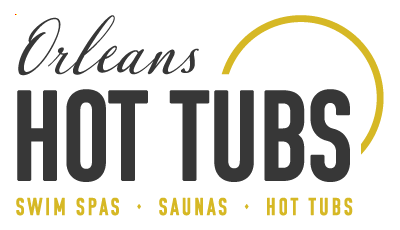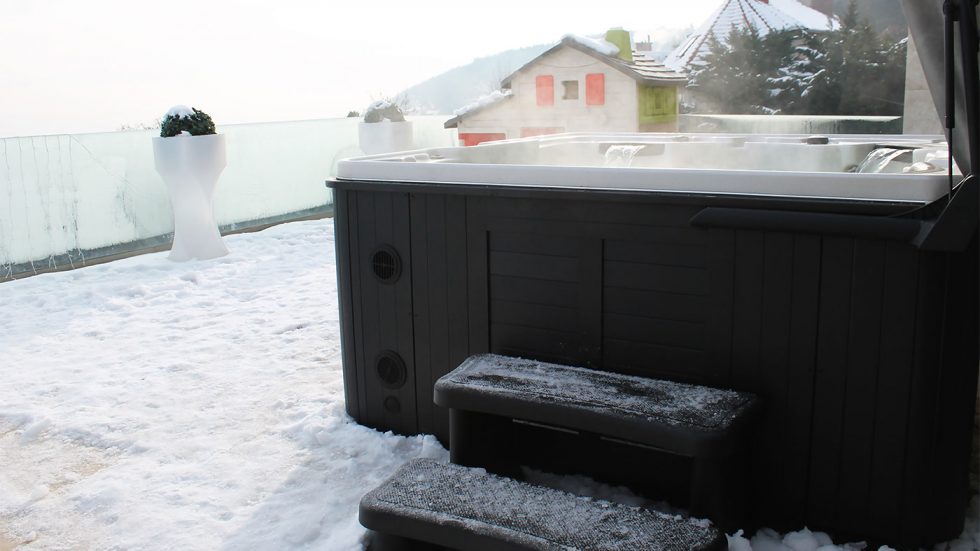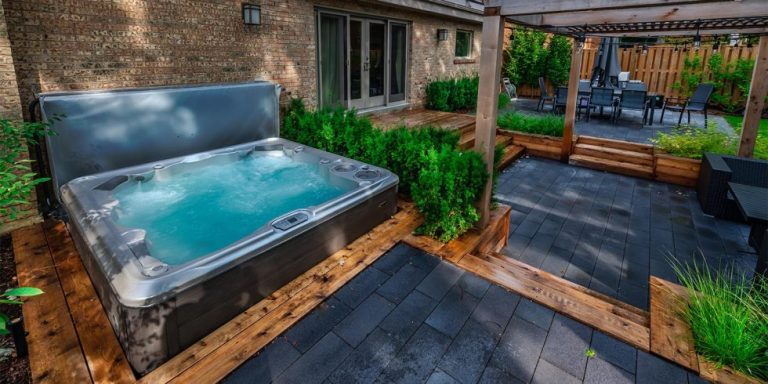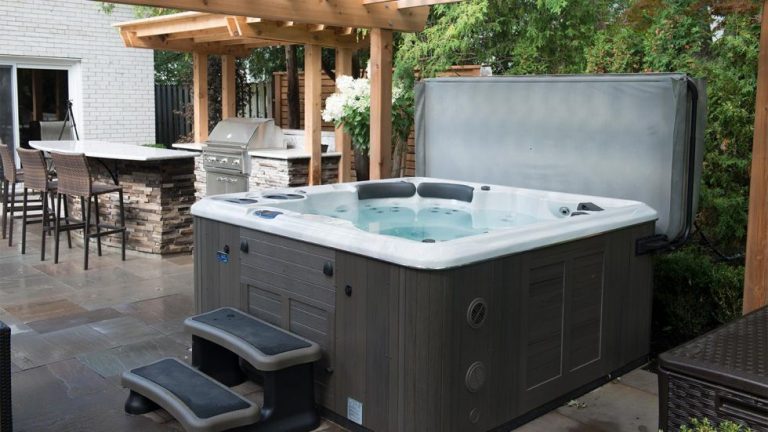Of all of the various components that make up a hot tub, none have a greater impact on its running costs than the hot tub’s insulation. Today, we will look at the most common hot tub insulation systems to see which does the best job at insulating your hot tub, as well as looking at a couple of ways that you can improve any hot tub’s insulating ability.
HOW DOES HOT TUB INSULATION WORK?
Hot tub insulation, like all insulation, works by trapping warm air and then using that warm air as a barrier to prevent colder outside temperatures from affecting the area within the insulation. Air is used for insulation as it doesn’t transfer heat very effectively and therefore resists changes in temperature.
Insulation systems slow the transfer of heat out of the hot tub by forcing heat to travel through hundreds or thousands of small air pockets, instead of simply radiating out through the cabinet. This massively slows down the rate at which heat can dissipate from the air inside the cabinet. Simply put, the slower the heat dissipates out of the hot tub, the more is retained in the hot tub for use in heating in the water.
WHAT ARE THE DIFFERENT TYPES OF INSULATION USED IN HOT TUBS?
There are three major types of insulation used in hot tubs; spray foam, fibre board and thermal shield insulation.
Spray Foam
Spray foam insulation is the most widely used insulation in hot tubs. It is a special liquid that when sprayed on a surface will expand and trap air as it dries. There are two ways that spray foam insulation is utilized in hot tubs, “full foam” and perimeter foam.
Full Foam Insulation
Full foam insulation is the most common way that hot tubs are insulated. In this system the spray foam is applied directly to the shell and plumbing of the hot tub, fully covering the hot tub shell and the majority of the plumbing. While this system is very effective at insulating the water, it does have a couple of potential drawbacks.
- If the foam gets wet it needs to be removed and replaced. Wet foam is completely useless as an insulator. Spray foam is also notorious for retaining water once it is absorbed. For this reason, even small leaks can lead to large repair bills as large areas of foam have to be removed and replaced.
- The heaters and pumps create a lot of waste heat. In a full foam system these components are outside of the insulated area meaning that all this waste heat is, well, wasted.
Perimeter Foam
In an effort to solve the issues of full foam insulation, some manufacturers have switched to a perimeter foam system. In this system, the insulation is added to the outer cabinet of the hot tub rather than the shell. This allows for the waste heat from the pumps and heater to be trapped within the insulation and used to further heat the hot tub water, while also leaving the plumbing more exposed to allow for easier repairs.
Perimeter foam isn’t without its own drawbacks, however. The first is a lack of support for the plumbing. Hot tub plumbing is heavy, especially when filled with water. By encasing the plumbing in spray foam, full foam systems not only insulates the plumbing, but also helps to support its weight. This added support reduces the potential for wear and tear on the plumbing and leads to fewer potential problems over time.
Perimeter foam also requires that vents be added to the cabinet of the hot tub so that the pumps don’t overheat in the warmer months. In the winter, though, these vents mean that some heat can easily escape the hot tub, reducing the overall effectiveness of the insulation in the time when it is needed the most.
FIBRE BOARD INSULATION
Fibre board insulation is used by a few hot tub manufacturers. Comprised of solid sheets of interwoven fibres, this insulation is used as an alternative to spray foam in some perimeter foam systems. While it is cheaper and easier to replace if it gets wet, fibre board insulation also leaves small gaps around each piece, reducing its overall effectiveness.
THERMAL SHIELD INSULATION
Thermal shield insulation is a thick “bubble wrap” style insulation that is commonly used in a variety of applications where high amounts of insulating value is needed in a relatively small space (like water heaters or astronaut’s space suits). This insulation typically has two sides:
- One side is reflective to redirect heat back into the airspace on the inside of the system.
- The other side is black to absorb any ambient heat coming from outside the system.
In hot tubs, thermal shield insulation is used in both perimeter foam and specialized two layer systems. In these two layer systems the first layer of insulation is wrapped around the shell and plumbing of the hot tub, while the second is wrapped around the outer cabinet of the hot tub. Two layer systems offer the best aspects of both the full foam and perimeter foam systems.
Thermal shield insulation also doesn’t absorb water like spray foam tends to. This means that the insulation won’t become saturated if it gets exposed to water; ensuring that your insulation is always running at peak efficiency.
The only drawback to thermal shield insulation is its R value. Each sheet of thermal shield provides the same insulating value as around 3″ of spray foam. This means that standard full foam hot tubs will generally provide better insulating value if there is only one layer of thermal shield insulation in the hot tub.
SO WHICH INSULATION IS BEST?
While each insulation system has it own pro and cons, on the whole thermal shield insulation provides the best energy efficiency; assuming that the hot tub has at least two layers of thermal shield.
HOW CAN YOU IMPROVE YOUR HOT TUB INSULATION?
CHECK THE COVER
Worn-out hot tub covers can dramatically increase your hot tub’s energy costs. In fact, continuing to use a worn-out hot tub cover can cost you $100s in added energy costs over the course of a single winter. One of the best ways to improve an older hot tub’s insulation, therefore, is to ensure that your cover is working at peak efficiency. There are two things you should be paying attention to:
- If the cover is still sitting flat around the edge of the hot tub. To do their jobs effectively, hot tub covers need to form a tight seal around the edge of the hot tub. Without this seal, there will be significant heat loss around the edge of the cover.
- If the cover has started to take on water. If the air pockets in the cover’s insulating foam start filling up with water, the efficiency of the cover will drop significantly; increasing your monthly energy costs.
How can you tell if your hot tub cover has started to take on water? Not only is air a much better insulator than water, it is also significantly lighter! If your hot tub cover is significantly heavier than when you bought it, chances are that it has become waterlogged. If placed on a cover lifter, you should be able to lift your hot tub cover with one arm fairly easily. If your cover is more difficult to lift than it is full of water and should be replaced.
CHECK FOR LEAKS
As we previously mentioned, spray foam insulation has a tendency to absorb and hold water, which drastically reduces its ability to retain heat. For this reason, it is a good idea to periodically check the inside of your hot tub cabinet to see if there are any wet spots.
If you notice any small puddles try to find the source of the leak and repair it before it becomes worse. You will also want to check for wet insulation. If you notice any insulation that has become saturated with water, remove it and replace it with dry foam to keep your hot tub’s working at peak efficiency.
CLOSE YOUR VENTS
If your hot tub utilizes a perimeter foam or two layer foam system you will want to ensure that your vents are closed going into the winter months. Some manufacturers like Hydropool allow you to easily do this by simply rotating your vents to the closed position. Others offer special “winter panels” that replace the vented section of your cabinet with one that is solid.
Some hot tub manufacturers offer no real method of closing the vents. If that is the case (or if you didn’t purchase winter panels) you can simply add in some insulation of your own to cover the vents from the inside of the cabinet.




